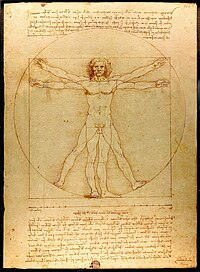Happy Human
| Part of a series on |
| Humanism |
|---|
 |
| Philosophy portal |

The Happy Human is an icon that has been adopted as an international symbol of secular humanism.[1] Created by a boy the figure was the winning design in a competition arranged by The British Humanist Association (BHA) in 1965.[1] Various forms of it are now used across the world by humanist organisations of all sizes including the BHA, International Humanist and Ethical Union (IHEU) and The American Humanist Association (AHA).[1][2][3]
The trademark is still held by the BHA, which freely licenses use of the symbol by bona fide Humanist organisations worldwide.[1]
Origins
The Happy Human was created in response to a British Humanist Association competition in 1965, after many years of discussion as to what a logo should look like. After some time without progress, radio presenter Margaret Knight backed a popular movement among the BHA's membership to commission such a logo, triggering publicity officer Tom Vernon to announce the competition. Of the several hundred designs from a number of countries were considered, Dennis Barrington's simple design was favoured for its perceived universalism. Within the space of a few years, the logo had emerged as a symbol of Humanism, not just of the BHA, and was adopted by humanist organisations around the world.[4]
Variations of the Happy Human Symbol
-
Original Happy Human symbol
-
Humanist Canada logo
-
Humanistisch Verbond logo
-
IHEU logo
-
IHEYO logo (International Humanist Ethical Youth Organization)
Organizations using the Happy Human
- American Humanist Association (US)
- British Humanist Association (UK)
- Council of Australian Humanist Societies (CAHS) (Australia)
- European Humanist Federation
- Asociația Umanistă Română (AUR) (Romania)
- LGBT Humanists UK
- Humanist Association of Ireland (Ireland)
- Humanist Canada (Canada)
- Humanist Society of New Zealand (New Zealand)
- Humanist Society Scotland (UK)
- Humanistisch Verbond (Nederland)
- Indian Humanist Union (India)
- Institute for Humanist Studies
- International Humanist and Ethical Union
- Norwegian Humanist Association (Norway)
- Primera Iglesia Humanista de Puerto Rico (Puerto Rico)
- Siðmennt (Iceland)
- Swedish Humanist Association (Sweden)
- Union of Rationalist Atheists and Agnostics (Italy)
Organisations using similar symbols
References
- ^ a b c d "The Happy Human Symbol". BHA. Retrieved 2 November 2013.
- ^ "Happy Human Symbol". IHEU. Retrieved 2 November 2013.
- ^ "American Humanist Homepage". Retrieved 2 November 2013.
- ^ Whitton, Liam (7 July 2015). "A 'Clash of Symbols': 50 years on from the design that carried Humanism around the world". HumanistLife. British Humanist Association. Retrieved 17 August 2015.






